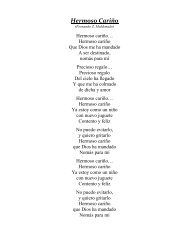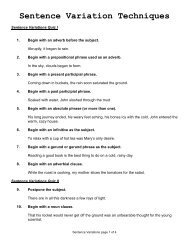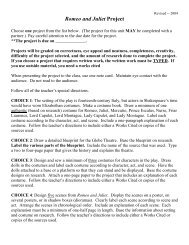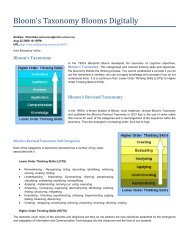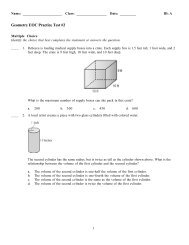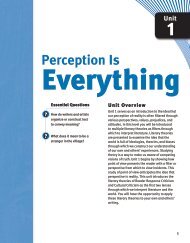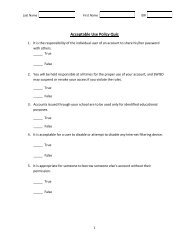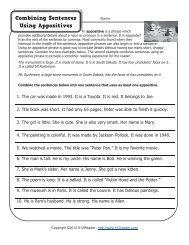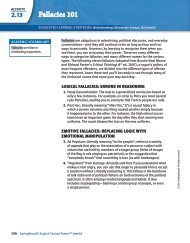Toulmin Thesis
Toulmin Thesis
Toulmin Thesis
You also want an ePaper? Increase the reach of your titles
YUMPU automatically turns print PDFs into web optimized ePapers that Google loves.
The Writing Center<br />
• Home<br />
• Make/Cancel an Appointment<br />
• Submit a Draft Online<br />
• Faculty Resources<br />
• Handouts<br />
• ESL<br />
• About<br />
• FAQs<br />
Home » Handouts » <strong>Thesis</strong> Statements<br />
Search this Search<br />
WHAT THIS HANDOUT IS ABOUT<br />
This handout describes what a thesis statement is, how thesis statements work in your<br />
writing, and how you can discover or refine one for your draft.<br />
INTRODUCTION<br />
Writing in college often takes the form of persuasion—convincing others that you have an<br />
interesting, logical point of view on the subject you are studying. Persuasion is a skill you<br />
practice regularly in your daily life. You persuade your roommate to clean up, your parents<br />
to let you borrow the car, your friend to vote for your favorite candidate or policy. In<br />
college, course assignments often ask you to make a persuasive case in writing. You are<br />
asked to convince your reader of your point of view. This form of persuasion, often called<br />
academic argument, follows a predictable pattern in writing. After a brief introduction of<br />
your topic, you state your point of view on the topic directly and often in one sentence. This<br />
sentence is the thesis statement, and it serves as a summary of the argument you’ll make<br />
in the rest of your paper.<br />
WHAT IS A THESIS STATEMENT<br />
A thesis statement:
• tells the reader how you will interpret the significance of the subject matter under<br />
discussion.<br />
• is a road map for the paper; in other words, it tells the reader what to expect from the<br />
rest of the paper.<br />
• directly answers the question asked of you. A thesis is an interpretation of a question or<br />
subject, not the subject itself. The subject, or topic, of an essay might be World War II or<br />
Moby Dick; a thesis must then offer a way to understand the war or the novel.<br />
• makes a claim that others might dispute.<br />
• is usually a single sentence somewhere in your first paragraph that presents your<br />
argument to the reader. The rest of the paper, the body of the essay, gathers and<br />
organizes evidence that will persuade the reader of the logic of your interpretation.<br />
http://writingcenter.unc.edu/handouts/thesis-statements/<br />
Observations:<br />
• "What is it that makes arguments work What makes arguments effective The British logician Stephen <strong>Toulmin</strong> made<br />
important contributions to argument theory that are useful for this line of inquiry. <strong>Toulmin</strong> found six components of<br />
arguments:<br />
• Claim: A statement that something is so.<br />
• Data: The backing for the claim.<br />
• Warrant: The link between the claim and the grounds.<br />
• Backing: Support for the warrant.<br />
• Modality: The degree of certainty employed in offering the argument.<br />
• Rebuttal: Exceptions to the initial claim.<br />
[T]he <strong>Toulmin</strong> model provides us with useful tools for analyzing the components of arguments."<br />
(J. Meany and K. Shuster, Art, Argument, and Advocacy. IDEA, 2002)<br />
• "[<strong>Toulmin</strong>'s] general model of 'data' leading to a 'claim,' mediated by a 'warrant' with any necessary 'backing,' has been very<br />
influential as a new standard of logical thinking, particularly among scholars of rhetoric and speech communication."<br />
(C. W. Tindale, Rhetorical Argumentation. Sage, 2004)
• Using the <strong>Toulmin</strong> System<br />
Use the seven-part <strong>Toulmin</strong> system to begin to develop an argument . . .. Here is the <strong>Toulmin</strong> system:<br />
0. Make your claim.<br />
1. Restate or qualify your claim.<br />
2. Present good reasons to support your claim.<br />
3. Explain the underlying assumptions that connect your claim and your reasons. If an underlying assumption is<br />
controversial, provide backing for it.<br />
4. Provide additional grounds to support your claim.<br />
5. Acknowledge and respond to possible counterarguments.<br />
6. Draw a conclusion, stated as strongly as possible.<br />
(Lex Runciman, Carolyn Lengel, and Kate Silverstein, Exercises to Accompany The Everyday Writer, 4th ed. Macmillan,<br />
2009)<br />
• "<strong>Toulmin</strong>'s model actually boils down to a rhetorical expansion of the syllogism . . .. Although the reactions of others are<br />
anticipated, the model is primarily directed at representing the argumentation for the standpoint of the speaker or writer who<br />
advances the argumentation. The other party remains in fact passive: The acceptability of the claim is not made dependent on<br />
a systematic weighing up of arguments for and against the claim."<br />
(F. H. van Eemeren and R. Grootendorst, A Systematic Theory of Argumentation. Cambridge Univ. Press, 2004)<br />
• "When I wrote [The Uses of Argument], my aim was strictly philosophical: to criticize the assumption, made by most Anglo-<br />
American academic philosophers, that any significant argument can be put in formal terms . . ..<br />
"In no way had I set out to expound a theory of rhetoric or argumentation: my concern was with twentieth-century<br />
epistemology, not informal logic. Still less had I in mind an analytical model like that which, among scholars of<br />
Communication, came to be called 'the <strong>Toulmin</strong> model.'"<br />
(Stephen <strong>Toulmin</strong>, The Uses of Argument, rev. ed. Cambridge Univ. Press, 2003)<br />
•<br />
http://grammar.about.com/od/tz/g/<strong>Toulmin</strong>modelterm.htm




